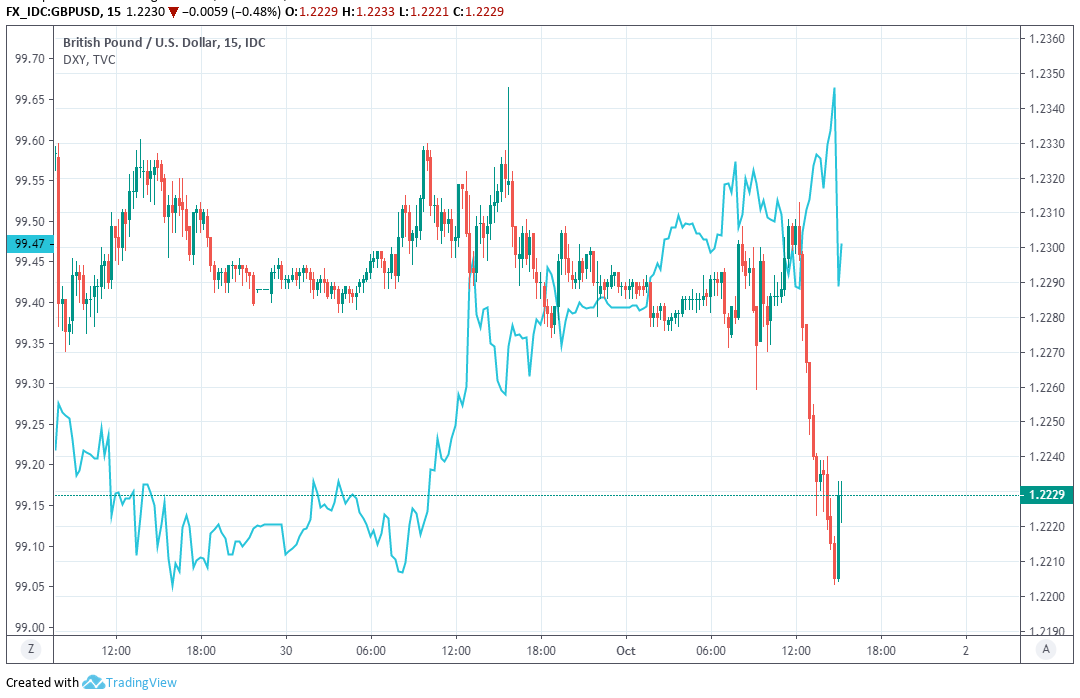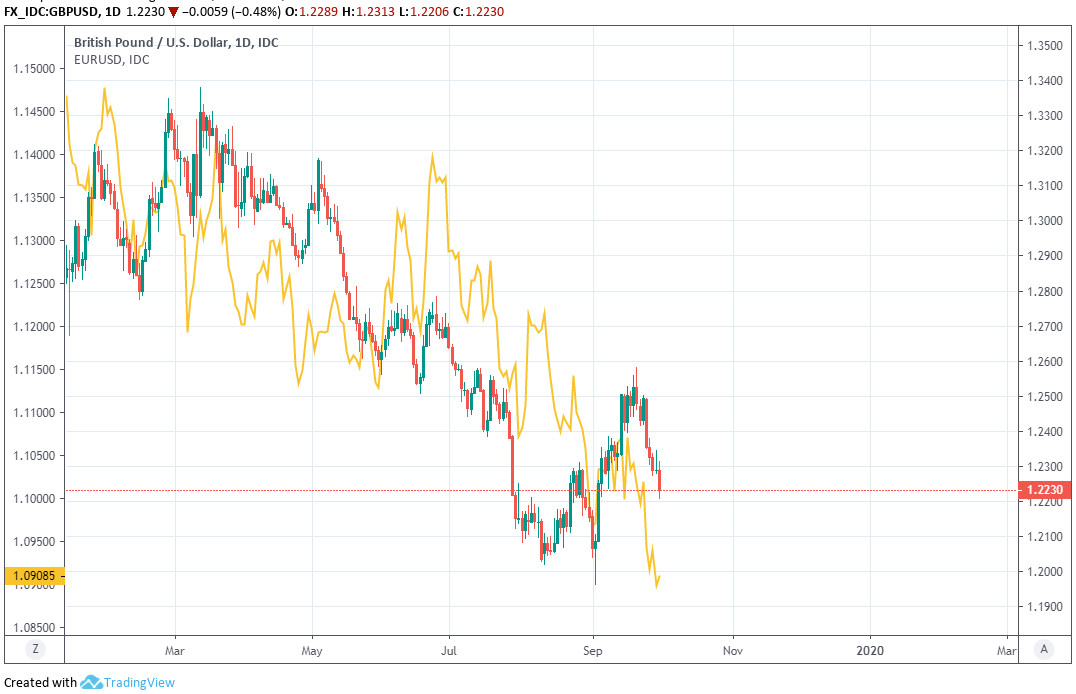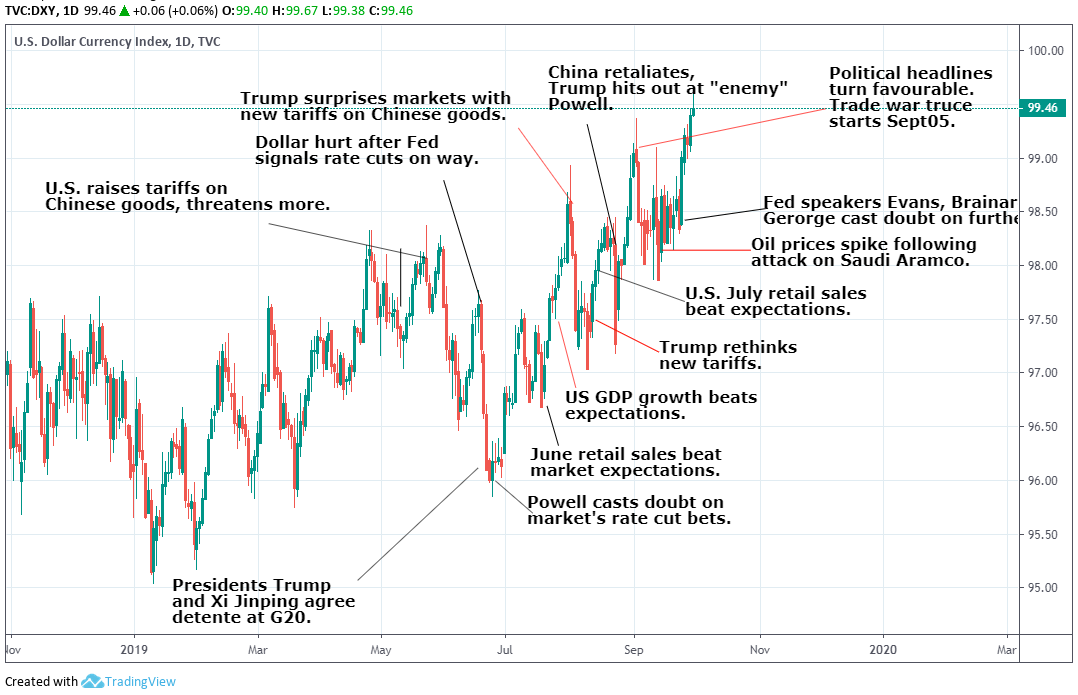U.S Dollar Left Wounded after Trade War Bites Economy
- Written by: James Skinner

© Adobe Stock
- USD crumbles into broad retreat after ISM Manufacturing PMI slides.
- Enables GBP/USD rate to catch breather from Brexit-related selling.
- U.S. manufacturers feel trade war pain in September, outlook darkens.
- GBP and EUR still tipped lower Vs USD, but more Fed rate cuts on way.
The Pound-to-Dollar rate stabilised briefly in the noon session Tuesday as the greenback crumbled in response to a dire Institute of Supply Management (ISM) manufacturing survey that showed President Donald Trump's trade war and the resulting global slowdown biting the U.S. economy in September.
September's ISM Manufacturing PMI surprised sharply on the downside Tuesday, dropping from 49.1 to 47.8 when markets had looked for it to rise to 50.4 last month. Weakness was broadbased too and the index, which is computed from surveys of of 400 purchasing managers in the U.S. manufacturing sector, is now at its lowest level for ten years.
"Notably, given the deterioration in the global growth backdrop, the index of new export orders sank all the way down to 41, after tracking above 60 in mid-2018. Separately, another cyclical sector of the US economy, construction spending, was weaker than expected in August at 0.1%, compounding a downwards revision to the prior month. Taken together, these data are in line with our expectations for another Fed cut before the end of the year," says Katherine Judge, an economist at CIBC Capital Markets.
As I predicted, Jay Powell and the Federal Reserve have allowed the Dollar to get so strong, especially relative to ALL other currencies, that our manufacturers are being negatively affected. Fed Rate too high. They are their own worst enemies, they don’t have a clue. Pathetic!
— Donald J. Trump (@realDonaldTrump) October 1, 2019
The only three categories to increase in the September ISM survey were the new orders index, the prices index and the index of GDP-reducing imports. Production output fell more than 2% last month, the employment index dropped more than 1% while both the deliveries and inventories indices also fell. And the index of new GDP-boosting exports dropped by 2.3%, the institute says.
PMI surveys measure changes in industry activity by asking respondents to rate conditions for new orders, production, hiring intentions, prices and inventories. A number above 50.0 indicates industry expansion while a number below 50 is suggestive of contraction. The survey results often correlate with official measures of output and growth although they can often be wide of the mark too.

Above: Pound-Dollar rate at 15-minute intervals, alongside the Dollar Index (blue line, left axis).
"If there’s any good news here, it is that the drop in the headline is due entirely to weakness in the lagging components," says Ian Shepherdson, chief economist at Pantheon Macroeconomics. "If orders have now stabilised, the headline index should not fall significantly further. But it is already weak enough to signal that the manufacturing sector will remain in recession for the foreseeable future...while capital spending and exports look set to roll over."
The global manufacturing sector has been in retreat for more than a year now as international trade declines in the face of President Donald Trump's trade war against China, which has damaged the world's second largest economy but arguably, hurt the trade-sensitive Eurozone even more than the two protagonists in the story. UK manufacturers are also contending with the nation's twice-delayed exit from the EU, which risks placing tariffs between the UK and some of its largest export markets.
"Big burn for the bulls on that ISM print," says Mark Wilson, chief market analyst at Markets.com. "After some shoddy PMI numbers in the EZ this morning, the beggar-thy-neighbour trade played out with the euro shooting higher versus the dollar...EURUSD has regained the 1.09 handle but the trend remains bearish – need 1.10 to break the trend. The pound also jumped a tad off its lows, having come under a fair amount of selling pressure today, but again the trend is weaker and a 1.21 handle is now in sight."
Chinese growth is slowing, Europe's economy is widely believed to be stagnating and Germany's economy already looks to be in recession due mainly to the damaging impact that President Donald Trump's trade war has had on international trade and manufacturing sectors the world over. This has already seen the European Central Bank (ECB) rush to support growth with an interest rate cut and fresh round of quantitative easing.

Above: Pound-Dollar rate at daily intervals, alongside the Euro-to-Dollar rate (blue line, left axis).
"The ISM manufacturing index has dropped to a 10-year low as trade worries, weak global growth and a strong dollar weigh on the sector. Given the threat of contagion to other parts of the economy further Fed rate cuts are coming," says James Knightley, chief international economist at ING. "It was below every single forecast in the market... These figures suggest that further output declines are likely and point to downside risks for Friday’s US jobs report."
U.S. rates are at least twice as high those of other major central banks except those in Canada and Norway, even after the policymakers cut the Fed Funds rate twice earlier this year. The contrast between the 2% rate of the Federal Reserve and its 0% European equivalent is one reason the Dollar has been so strong in recent months, because the U.S. bond market is effectively the only game in town for yield hungry investors. But the trade war now looks to be catching up with the U.S. too.
Nonfarm payrolls numbers for September will round off on Friday what is set to be an action-packed week as far as economic statistics go, and one that was originally tipped by many to emphasise and underline the outperformance of the U.S. economy relative to its developed world counterparts. That outperformance has been key to the Dollar's strength and resilience in the last 18 months, but so far it's not been forthcoming this week.
Bloomberg News reported Friday that Trump is considering limiting some American investment flows to China, which would be an aggressive step that marks yet another escalation in the trade spat. The two sides are set to hold talks in Washington on October 10 and 11 but if an agreement isn't reached, the White House could lift the tariff rate imposed on around $250 bn of China's annual exports to the U.S. from 25% to 30%. Further tariffs are also scheduled to go into effect on December 15.

Above: Dollar Index shown at daily intervals and annotated for recent events. Click for larger image.
Time to move your money? Get 3-5% more currency than your bank would offer by using the services of foreign exchange specialists at RationalFX. A specialist broker can deliver you an exchange rate closer to the real market rate, thereby saving you substantial quantities of currency. Find out more here.
* Advertisement




